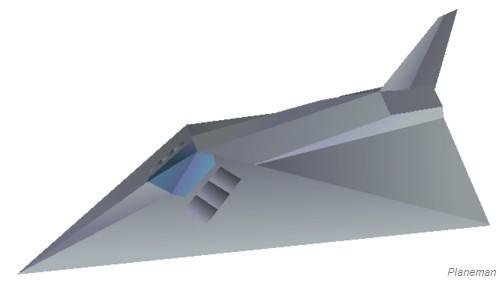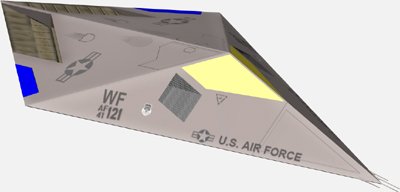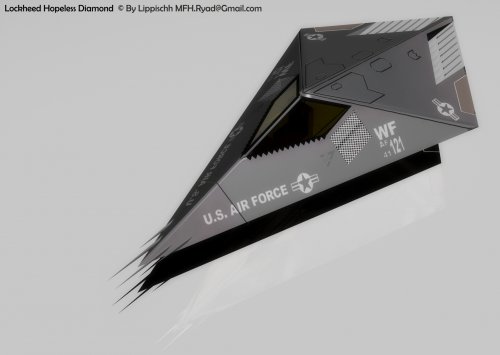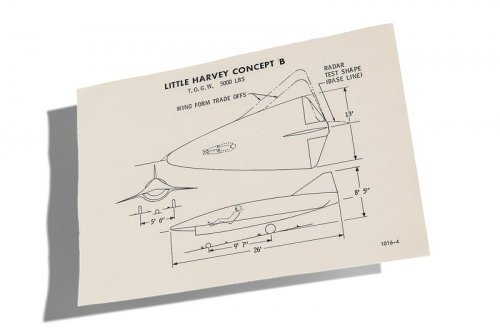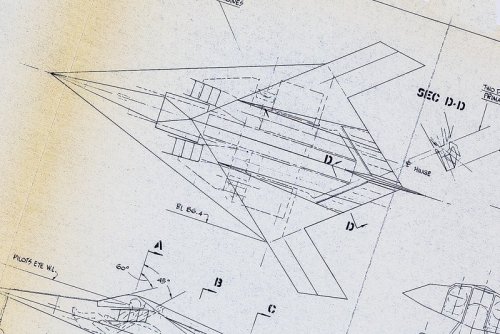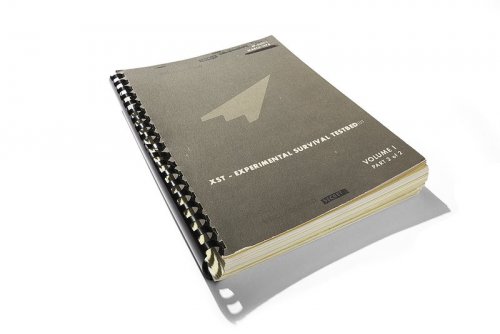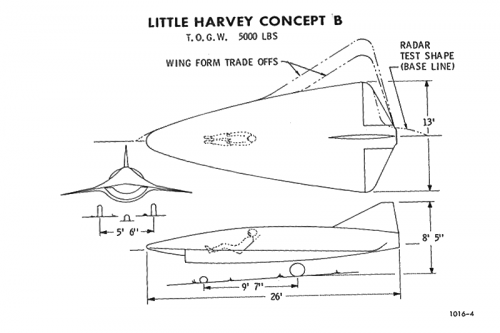You are using an out of date browser. It may not display this or other websites correctly.
You should upgrade or use an alternative browser.
You should upgrade or use an alternative browser.
Hopeless Diamond to HAVE BLUE: Lockheed XST Evolution
Apollo Leader
ACCESS: Restricted
- Joined
- 22 May 2007
- Messages
- 34
- Reaction score
- 15
Whoever made those 3D models did a lousy job. His Have Blue is way out of proportion (Looks like an F-117 crossbread with some of Have Blue's features). His Senior Peg is based off of the artwork that is over at Dreamland Resort. Senior Peg was a much more distinctive flying wing shape as opposed to being an F-117 on steroids. 
I doubt theyApollo Leader said:Whoever made those 3D models did a lousy job.
're "3D models." Looks more like 2D clip art.
Apollo Leader said:(Looks like an F-117 crossbread with some of Have Blue's features).
i find it looks more like a crossbread between Have Blue and MBB Lampyridae.
however this design doesn't look right to me.
regards,
gTg
lippischh
ACCESS: Secret
this a model that i've done by myself.
contact me: MFH.Ryad@Gmail.com.
contact me: MFH.Ryad@Gmail.com.
Attachments
lippischh
ACCESS: Secret
Dear ikke666,
i don't get what do you wanted to say :-\
what does it mean ordered in fiscal year....?
regards.
i don't get what do you wanted to say :-\
what does it mean ordered in fiscal year....?
regards.
- Joined
- 6 November 2010
- Messages
- 5,270
- Reaction score
- 5,534
The number 41 below the AF mark means, in current USAF practice, that the aircraft was ordered in Fiscal Year 1941. That is, unless part of the Hopeless Diamond funding was booked in FY2041
- using a time-machine, spin-off from the B-2 electrogravitics research
- just wrongly booked intentionally to obfuscate
More info here: http://www.joebaugher.com/usaf_serials/usafserials.html
- using a time-machine, spin-off from the B-2 electrogravitics research
- just wrongly booked intentionally to obfuscate
More info here: http://www.joebaugher.com/usaf_serials/usafserials.html
lippischh
ACCESS: Secret
Hi everyone,
i didn't pay attention to the serial i putten, actually i so this serial number in a 3d model in a website.
thanks for the information.
i just wanted to know if my render was good.
thanks.
i didn't pay attention to the serial i putten, actually i so this serial number in a 3d model in a website.
thanks for the information.
i just wanted to know if my render was good.
thanks.
- Joined
- 3 June 2006
- Messages
- 3,095
- Reaction score
- 3,974
ikke666 said:@ lippischh
aircraft ordered in fiscal year 1941???
strange....
Reminds me of The Philadelphia Experiment II!
hole in the ground
ACCESS: Secret
- Joined
- 6 August 2008
- Messages
- 235
- Reaction score
- 23
Ive done only a very basic guestimate of size comparing a 3 view of hopeless diamond to an f117, assuming that the cockpit sizes would be much the same. I come up with hopeless diamond being in the region of 60% the size of the f117. This would have made it about 12.5 meters long does this sound reasonable to people? Does anyone have a better value for its size?
hole in the ground said:Does anyone have a better value for its size?
Yes.
Sorry I can't be more specific, but in a few months someone (not me) will publish hard data on the Hopeless Diamond which will nail down dimensions precisely.
More when I can say more. A little bit of patience, and your curiosity will be satisfied.
hole in the ground
ACCESS: Secret
- Joined
- 6 August 2008
- Messages
- 235
- Reaction score
- 23
Oo! That's a bit of a tease. Curiosity set to 11 now!
It won't slip by un-noticed hereabouts when it's published. Had I said nothing, it would have still been noticed promptly and immediately discussed. It'll be readily and easily available.
hole in the ground
ACCESS: Secret
- Joined
- 6 August 2008
- Messages
- 235
- Reaction score
- 23
Rgr, out!
- Joined
- 27 December 2005
- Messages
- 17,785
- Reaction score
- 26,804
Kelly Johnson's 1975 XST design
Source: http://www.airspacemag.com/military-aviation/secrets-skunk-works-180952122/
Source: http://www.airspacemag.com/military-aviation/secrets-skunk-works-180952122/
A May 1975 Skunk Works report, “Progress Report No. 2, High Stealth Conceptual Studies,” includes this early drawing from a stealth aircraft study called Project Harvey (named after the invisible rabbit in the 1950 James Stewart movie); the program eventually led to the F-117. Based on results from D-21 drone flights, Kelly Johnson believed that Little Harvey’s smoothly blended shapes offered the best combination of speed and stealth. Ben Rich, Johnson’s protégé, argued for faceted angles. It was one of the rare times Johnson’s design did not prevail.
Attachments
- Joined
- 27 December 2005
- Messages
- 17,785
- Reaction score
- 26,804
Project Harvey, an initiative to develop a radar-undetectable aircraft, was followed by a tailless rhomboid design, quickly renamed the Hopeless Diamond when Lockheed engineers discovered that while it was truly stealthy, it was uncontrollable in flight. This drawing shows the outboard wings and single tail that were tacked on to improve stability. The Harvey studies evolved into Lockheed’s Have Blue stealth demonstrator, the direct precursor to the F-117.
http://www.airspacemag.com/military-aviation/secrets-skunk-works-180952122/
Looks like a B-2 rammed into the back of an F-117...
Attachments
- Joined
- 27 December 2005
- Messages
- 17,785
- Reaction score
- 26,804
Dated March 1976, this 250-page document gave the Defense Advanced Research Projects Agency a technical summary of the XST, the design that evolved into the Have Blue flying prototype and eventually led to the F-117. It showed program personnel that every stealthy configuration choice involved tradeoffs, affecting radar signature, flight stability, cost, and performance. Crammed with engineering data, it was not declassified until 2012—and there are still pages off-limits to the public.
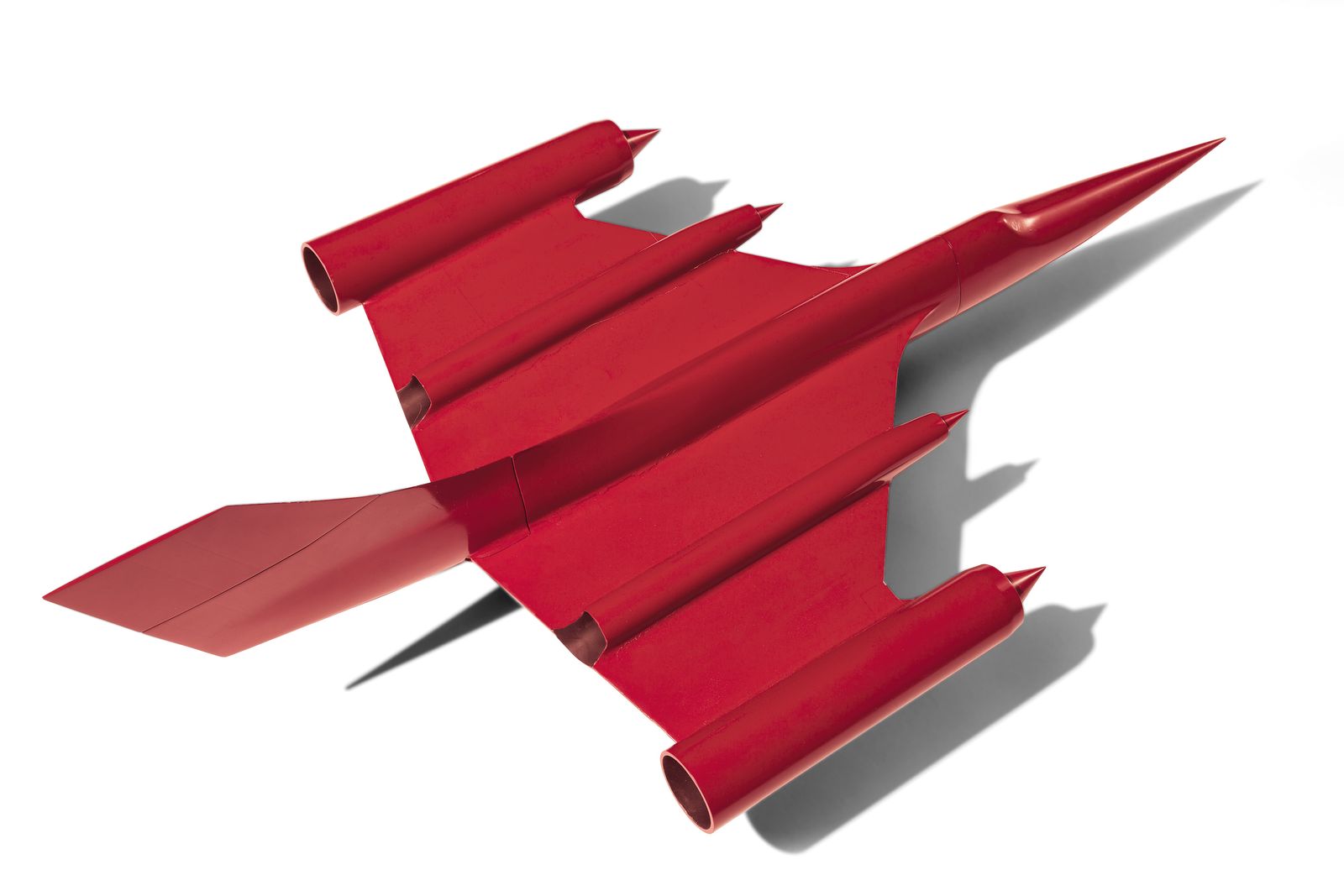
Secrets of the Skunk Works
Exclusive photographs of once-classified inventions from Lockheed’s famous brain trust.
Attachments
- Joined
- 2 August 2006
- Messages
- 3,257
- Reaction score
- 1,532
Thanks! That's all very interesting, partly because I just finished reading the AIAA book about the development of the F-117A and they talk about in one of the appendixes how some people thought it was developed under the code name Project Harvey, but that no such aircraft or program ever existed. Now we know where it originated. 
Mat Parry
ACCESS: Secret
- Joined
- 25 January 2011
- Messages
- 416
- Reaction score
- 27
PaulMM (Overscan) said:Project Harvey, an initiative to develop a radar-undetectable aircraft, was followed by a tailless rhomboid design, quickly renamed the Hopeless Diamond when Lockheed engineers discovered that while it was truly stealthy, it was uncontrollable in flight. This drawing shows the outboard wings and single tail that were tacked on to improve stability. The Harvey studies evolved into Lockheed’s Have Blue stealth demonstrator, the direct precursor to the F-117.
http://www.airspacemag.com/military-aviation/secrets-skunk-works-180952122/
Looks like a B-2 rammed into the back of an F-117...
It does, it also looks like a lanky version of NG's cranked kite planforms e.g. X-47B (& possibly "others")
PaulMM (Overscan) said:Looks like a B-2 rammed into the back of an F-117...
I found it a bit odd that A&S didn't run the whole diagram. Oh, well, I wonder if someday someone might find advantage in that and produce their own good, clear diagrams off of that...
Walks away, whistling nonchalantly...
Orionblamblam said:PaulMM (Overscan) said:Looks like a B-2 rammed into the back of an F-117...
I found it a bit odd that A&S didn't run the whole diagram. Oh, well, I wonder if someday someone might find advantage in that and produce their own good, clear diagrams off of that...
Walks away, whistling nonchalantly...
Didn't you say the other day that somebody was going to put out a bunch of XST related stuff? Is it from this Smithsonian source or something else?
Didn't say "a bunch." But there is more to this diagram than A&S is apparently showing. Hmmm.
- Joined
- 6 August 2007
- Messages
- 3,918
- Reaction score
- 6,075
Sundog said:Thanks! That's all very interesting, partly because I just finished reading the AIAA book about the development of the F-117A and they talk about in one of the appendixes how some people thought it was developed under the code name Project Harvey, but that no such aircraft or program ever existed. Now we know where it originated.
There's a bigger, more complex story behind the Harvey name.
- Joined
- 18 March 2008
- Messages
- 3,529
- Reaction score
- 1,001
quellish said:There's a bigger, more complex story behind the Harvey name.
Brig. Gen. Jimmy Stewart, USAF SAC?
- Joined
- 27 December 2005
- Messages
- 17,785
- Reaction score
- 26,804
- Joined
- 26 May 2006
- Messages
- 34,952
- Reaction score
- 15,860
hole in the ground
ACCESS: Secret
- Joined
- 6 August 2008
- Messages
- 235
- Reaction score
- 23
Have I missed this or do I need to be more patient?
There have been changes in plans, and I've been asked to hang back. All I can say: I suspect if what being worked on comes to pass, you'll be like...

Sadly, you won't be tossing money *my* way, but still...

Sadly, you won't be tossing money *my* way, but still...
XP67_Moonbat
ACCESS: Top Secret
- Joined
- 16 January 2008
- Messages
- 2,272
- Reaction score
- 550
Tease backed by another tease. The plot thickens! :-D
- Joined
- 27 December 2005
- Messages
- 17,785
- Reaction score
- 26,804
Relevant section from Alan Brown, Lockheed, oral history interview from http://hdl.huntington.org/cdm/ref/collection/p15150coll7/id/7963
There was no chance of our bombers, which were
strategic B-52s, penetrating the modern Soviet defenses. We had to come up with something
that was going to enable us to do that. One of the things is reducing the radar cross section of
our airplanes. Dick Scherrer, who was working with Leo Celniker in advanced design in the
'60s, worked on a very small side contract called Harvey, named after the invisible rabbit, in
1973, to look at what designs they could come up with to improve the radar cross section. This is
not in the Skunk Works; this is in the main part of Lockheed. What he came up with wasn't
really terrific, but there was a general feeling that somehow things had got away from us. Why
was it that the modern fighter, the F-15, which carried one man and armaments, weighed 50,000
pounds, whereas World War II fighters, also carrying one man and armaments, weighed 5,000
pounds? We'd just grown these airplanes, and they just got big; can we just make smaller
airplanes? Well, it turns out that smaller is not good enough for a low radar cross section, but
that was what Dick worked on in the 1973-'74 period.
BROWN: I was talking about Dick Scherrer's Harvey program. Leo Celniker got called over to
the Skunk Works to help out in something that they were doing over there. Well, then Leo called
me and said, "You know, I'm having a real hard time with the propulsion guys in the Skunk
Works, because we're coming up with designs that are not going to do the job." I don't know if
you're familiar with the basic radar equations; I'm sure you're not. The basic radar problem was
that you could detect a B-52 at the horizon with Soviet early warning radars of that period, and
of course much easier with modern ones now. When they're flying at 35,000 feet, that's 200
miles away. 200 miles is 20 minutes of flying at 600 miles an hour. That gives the enemy time
to finish their cup of coffee, finish their cigarette, finish their conversation about whether
Moscow Dynamo is a better soccer team than Kiev, and then call up the surface-to-air missiles
and the airfields and say, "There's a guy coming in. Go and intercept him." If you cut the radar
cross section down to a level where they're only picked up at 100 miles, then that drops it down
from 20 minutes to 10 minutes, and you still have plenty of time to do all this. Now, it turns out
that to drop the distance down by a factor of two, you have to drop the radar cross section down
by a factor of 2 to the 4th. So it's a factor of 16, and you're still not doing any good. You really
have to change the distance by about a factor of 10. You have to get to where there's only two
minutes' warning instead of 20 minutes. And then it starts to be difficult for the enemy.
Well, a factor of 10 on distance is a factor of 10,000 on radar cross section. That's a
ludicrous engineering multiplication. Modern commercial transport designers, like Boeing and
the European teams, will sell their families into white slavery for five percent of fuel economy.
So a factor of 10,000…you know, the very simple analogy that I used to use is that this is like
somebody at General Motors saying there's a great shortage of gasoline in the world. We are
currently able to do 30 miles to the gallon. We have to multiply that by 10,000 and get 300,000
miles to the gallon. That's 12 times around the earth on a gallon of gas. Well, they would take
you to the local lockup and put you in a straitjacket if you suggested that.
WESTWICK: Right. So the radar equations go as the fourth power?
BROWN: Yeah, the fourth power relative to distance. So I'm quite sure that's why nobody even
thought it was a practical thing to do. And I'll come back to that particular thing relative to the
Russians later. Anyway, Leo called me and said, "Look, I'm having real problems. These guys
in the Skunk Works are still trying to make an improvement of an SR-71 airplane." I used to
have an imaginary sign over my door that says, "Nothing fails like success," rather than the old
saying that "Nothing succeeds like success." Historically I found that people, particularly if
they're in a winning situation, tend to stay with their last design, or last war or whatever it was.
It's interesting to note how many times in military competitions the builder of the previous
airplane or vehicle finishes last in the next competition. Classic examples are the competition for
what became the F-22 Lockheed Raptor. This was a direct replacement for the F-15, but it had to
be stealthy. McDonnell Douglas finished seventh out of seven in the competition after that. In
the competition for what became the C-17 transport, Lockheed, which had built every transport
for the Air Force prior to that, lost decisively to Douglas, later becoming McDonnell Douglas,
because we didn't listen to the Air Force. It's the same thing: you tend to go in with, “this is what
you really want, guys. We've done this before.” And the Air Force says, "You know, it would
be nice if you would read what we asked for." That's very typical.
So the SR-71 people, because the SR-71 is certainly an exceptionally good airplane but
not a stealthy one, were still clinging to those ideas. So Leo said, "Will you come over and see
if you can come up with a new propulsion installation design?" The F-15 airplane, for example,
has a radar cross section at air-to-air frequencies of about 10 square meters. We measure things
in square meters. The nose-on cross section, say, is about 10 square meters. The two inlets
themselves contribute pretty much all of that 10 square meters. That's because energy that goes
into a cavity will go in, rattle around, and come out like a pair of auto headlights pointing straight
back to the radar. So that's the dominant return. He said, "This is giving me fits. We've got to
solve the inlet problem." I came across, and I was going to come across for six weeks to work
on these Have Blue—what was their airplane was called? The XST, Experimental Stealth
Technology.
WESTWICK: Right. So the DARPA program is now…
BROWN: The Harvey program is history. That really never came out.
WESTWICK: That was not Skunk Works. Harvey was Dick Scherrer…
BROWN: Harvey was actually done by Dick Scherrer outside the Skunk Works. Dick Scherrer,
however, was brought over with Leo Celniker into the Skunk Works to work on the XST program.
WESTWICK: Okay. And your implication is that the Skunk Works people had become wedded
to the SR-71 approach.
BROWN: That's what it seemed, yes.
WESTWICK: A lot of times the story that you get from the Skunk Works people is that the SR-
71 was stealthy in some respects…
BROWN: It was.
WESTWICK: …and that there was some heritage from that.
BROWN: Oh, absolutely. There was a big heritage. I'll explain all the bits and pieces of that.
Let me just diverge, in fact, and talk about the SR-71. The SR-71 was probably one of the
greatest engineering feats in an airplane in the postwar period. It still holds a great number of the
altitude and speed records, and this is from 1965 to 2010, 45 years, a very substantial period of
time. It was a brilliant airplane. It had a lot of innovations in terms of materials, how do you
handle hydraulic fluid, the temperatures that you get at 100,000 feet, an enormous number of
problems that came up.
The general physics of what was needed was quite well known in the '60s. Books had
been written about it and so on—well, not at the time of the SR-71. Books were written about it
by 1967 to 1969. But there was no good calculation procedure that was good and quantitative
because there wasn't the computer capability to do that. It turns out later, when I was eventually
running the stealth technology part for Lockheed in the '80s, that our particular department was
occupying 80 percent of the Lockheed computer capability. The stealth stuff is very computer
intensive. So although the physics of stealth was known in the SR-71 days, there was no
practical way of doing an analysis to really get a low observable airframe comparable to what we
did with the XST and the F-117. However, there was a very good materials department, which
determined how to make the material for the radar-absorbing edges that go all around the
periphery of the airplane. These were about 12 inches to 18 inches deep—I think they're
probably 12 inches on the SR, perhaps a bit more than 12; something like 12 to 18 in different
parts. This was a very, very good piece of work. The materials lab started with the U-2. The U-
2 was recognized very early on as not being a very survivable airplane once Russia had active
surface-to-air missiles, as of course was proven by the Gary Powers incident. Work was done
almost immediately after the U-2 trying to come up with both improvements to the U-2 itself to
improve its stealth characteristics, and on new airplanes that were going to replace it, which
would be much more effective.
Of course if you're fighting to survive, there are several approaches you can take. The
SR-71 had a combination of moderately low radar cross section, primarily due to the very good
materials lab work done on the edges, and also operational capability of Mach 3-plus and 95 to
100,000 feet. In fact very much later I attended meetings at the CIA long after the Cold War is
over where Russian army people who were involved in their defenses would state categorically,
having had the opportunity of looking over all the U-2 and SR-71 flight logs, that they had
tracked our airplanes a hundred percent of the time. No, they had tracked every airplane but had
no way, until the Gary Powers incident, of shooting down the U-2 because the MiGs fly up to
50,000 feet and the U-2 was at 68,000 feet, and they couldn't intercept. Our pilots would report
seeing MiGs circle underneath them. So they identified them, but they couldn't do anything
about it. When the SR came along, then their missile capability was totally unable to handle a
Mach 3 airplane at that altitude. So the SR-71 was detected but never able to be intercepted.
Now, the latest thing of course is that we want strategic bombers to penetrate Soviet
Russia, and that doesn't work at 100,000 feet. You can't bomb very successfully from that
altitude. So that was the reason for this. DARPA put out a request, we found out later, to all the
people who had recently been involved in fighter development, to compete for the XST program.
Lockheed was not included in that group because Lockheed had not built a fighter since the F-
104, which was prehistory. One of my particular complaints about our government security
system is it works very well to some extent, but in this case the one company that had 90 percent
of the radar reduction experience in this country was excluded because DARPA didn't know
anything about what they were doing. The whole U-2 and SR-71 program was conducted under
CIA guidance, and DARPA had no understanding of that. One of the issues that I've always had
with the security in this country is there hasn't been enough cross-pollination across top high
levels, within, say, the Pentagon or the Advanced Research Project Agency or NSA or whatever,
so that top level people really know what's going on. There’s so much compartmentalization that
brilliant things can be done and the right people don't necessarily know. That's not a side issue,
but it's one that I'm very concerned about.
WESTWICK: Well, that was one of my questions actually.
BROWN: Anyway, we got into the XST program totally by accident. At that stage it was at a
Confidential level and not Secret or Top Secret because there was no real strong feeling that the
problem was soluble, because of the radar equation reasons I mentioned earlier. So it started off
with the seven fighter companies, including people like Fairchild Republic, North American,
Northrop, Grumman; McDonnell Douglas, of course, because they bid on the F-15. General
Dynamics had done the F-16. So those were the seven companies I think I just mentioned.
Fairchild Republic and some of the others were really not in the game at all. Well, these were
the people who were asked. One of our program managers was managing a stealthy missile
program for the U.S. Navy and was in the Pentagon. This fellow's name was Warren Gilmour.
Because this thing was just Confidential, the Navy program guy he was talking to said, "By the
way, are you guys in this new XST program that DARPA's running?" And Warren said, "No.
Never heard of it." "Oh, you should be in it because you know all about this radar stuff." So
Warren comes back and tells Ben Rich. Kelly had just recently retired; this was spring of 1975.
Warren says to Ben, "Hey, there's a program going on that we should be in." So Ben gets on to
DARPA, explains to them that although he can't give details, we do have some good experience
in this area, and we'd like to get into it. DARPA says, sorry, we haven't got any more money.
So Lockheed goes in on a free pass and spends its own money to do this development. Very
quickly, it had gotten down to McDonnell Douglas and Northrop. McDonnell Douglas dropped
out, and we came in about that time. So there was Northrop and Lockheed, and then we had a
competition with them, which we won. But it was interesting that we got in the back door totally
by an accidental conversation. Otherwise it might never have happened at all. Anyway, I was
asked to come over, once we got this thing. Of course we were working very quickly because
we just got in in the last month or two. Dick Scherrer was the one who did the initial layout
design for our XST, along with one designer called Kenny Watson, and Denys Overholser was
the man in the computational area who was doing the radar equation calculations.
WESTWICK: He was the one who read the Soviet paper and came up with a faceted design?
BROWN: Correct, right.
WESTWICK: Okay. And you had already come up with that design before the NorthropLockheed
competition?
BROWN: Before the competition came down to just the two people. What happened was, at
this time Denys had come up with a design which was sort of a shallow pyramid. The pyramid
was actually screeched in a little bit. It wasn't a symmetrical pyramid; it had sweep-back lines, so
there were no lines at right angles to directional flight. So it was a pyramid that came up like
this, and then the peak was sort of moved forward up and then down. He said, this is going to
give a very low radar cross section. And I remember Ben saying, "Do you mean as small as an
eagle?" And Dennis said, "Try an eagle's eye."
Now that phrase, of course, is a Top Secret phrase, if anybody knows what a sphere the
size of an eagle's eye would be. In fact Ben had this comment in his book The Skunk Works,
which the security people at the Air Force went nuts about—I mean they were going to throw
him in jail. Of course the good news was Ben was old enough and retired and revered.
Eventually he died anyway, so it never happened.
Anyway, that was the starting point. The aerodynamics people in the Skunk Works, who
again were SR-71 folks, immediately decided to make a wind tunnel model of this to prove that
it was totally useless as an airplane. They dubbed it the Hopeless Diamond. That's where that
phrase came up, if you've ever heard it.
WESTWICK: Right. I have heard of that.
BROWN: Well, it came up because the aerodynamics guys called Denys's pyramid shape the
Hopeless Diamond. Now, the pyramid shape was only intended to show how low of a radar
cross section you could get out of some reasonable-sized object. I came on board and Dick
Scherrer came on board about that time; I was just after Dick. The first thing we did is sort of
chop the pyramid down and put a trailing edge of it on it, like the F-117. So the pyramid now
starts to look a bit more like a possible airplane. I got involved about this time because that part
of the pyramid at the back end was going to be our exhaust nozzle, and that was the shape it had
to be. That's very different from an SR-71 exhaust nozzle, which is just two circles at the back
and two circles at the front. The reason it was two circles at the front and back is that, although
the radar guys would have liked to have puts slants on that thing, Kelly Johnson said, “you know,
it's tough enough to make a Mach 3 inlet on an airplane that's going to work from zero speed up
to about Mach 3-plus without you guys deciding to put a cross-wise slant on it, because an
axisymmetric inlet is something I can cope with. We'll put lots of absorbing material on it to
take care of that.” So the material side worked well, but in fact the main radar return from an
SR-71 is from the combination of the inlet circle and the exhaust circle, energy going across the
airplane and reflecting back directly off the inlet. And that was recognized. They did the best
they could, and it came to a pretty low radar cross section. For instance, where the F-15 had a
value of 10 square meters, the SR-71, which is a much bigger airplane, had a value of about one
square meter. But that still wasn't the factor of 10,000 that you really need to be effective for
something that works at low altitude.
Anyway, I came on board to help on the inlet design, and I worked with Denys
Overholser, who was the radar computation guy. I think because of some of my electromagnetic
background and experience from the Polaris, and generally having a reasonable balance of
electromagnetics and aerodynamics, I was able to understand what we needed and do a design
for the inlet. I came up with an inlet design, which in fact is patented by Lockheed in my name—
of course it doesn't do me any good because nobody else in their right mind is going to make
something like that for other reasons. Whereas for the F-15 essentially a hundred percent of the
energy that goes in comes out, that now reduced the radar cross section return to one part in a
hundred thousand. So in other words, I essentially caught everything that was going in, as that
was the dominant part of the return.
WESTWICK: So are there baffles in there or…?
BROWN: It was different things. I could actually show you some old viewgraphs that I have, or
stuff on the computer which shows what this is like, or I could sketch it for you. Basically the
way the periphery of the SR-71 is done, because of the high temperature, these edges on the SR-
71 are made of asbestos material, because that's essentially a so-called dielectric. On the F-117 it
can be made of fiberglass because it's only a Mach 0.9 airplane. Basically for the edges, you
want to have a sharp pointed edge. You don't want a rounded edge because that gives a very
large return to radar. So you want a sharp pointed edge, but even a sharp pointed edge gives a
significant return compared to what you want, particularly at low frequencies. So what we do is
we go back about 12 inches with a fiberglass honeycomb—in the case of the SR-71 it was an
asbestos honeycomb—and then we grade that in with carbon particles, where we have a very
light loading of carbon particles initially and increase the strength of carbon particles until we get
to a very heavy loading back here. And those carbon particles absorb the radar without giving
you a strong reflection. It's like a soft hydraulic shock absorber; it's an electromagnetic shock
absorber essentially. It starts off soft so the energy doesn't bounce off the front edge and then
gradually hardens up.
WESTWICK: This is the leading edge of the wing?
BROWN: It's around the entire periphery of the airplane and on the fins and everything. So if
you use the same technique on the inlet, instead of just making that just a fiberglass honeycomb
leading edge, we'll make it a honeycomb going in this direction. And the dimensions of the
honeycomb were about six-tenths of an inch because if you have a microwave transmission lines,
these things tend to be rectangular tubes where you can send electrical energy with very small
losses over very long distances. They use these in telephone, microwave…
WESTWICK: Like wave guides?
BROWN: Wave guides. It's a wave guide. And a wave guide which has dimensions equal to
one wavelength is extremely efficient and with very low losses. However, if you reduce the
wave guide size to being under half a wavelength, it suddenly acts like a drum skin, and energy
does not penetrate it at all. So what we did is we made the fiberglass thing of dimensions which
were less than half a wavelength at the highest wavelength that we thought we might encounter
in the next 20 years, which turned out to be about five or six-tenths of an inch. And so these
fiberglass tubes go back about six inches and have the carbon loading like the leading edges of
the wings. So that's what we used for the inlet. Then once you're inside the inlet, you have a
heavy amount of absorbing material. For the engines, it turns out the engine manufacturers knew
nothing about Stealth. So the engines are just plain engines. In fact they were stolen off the T-
38 line by the U.S. Air Force for the Have Blue Program. So they just became major reflectors.
But when they reflect back to the very highly loaded carbon area at the back of the fiberglass
grid, it tends to bounce back and stay inside. So what energy does go through between the grids
and the engine face and is not absorbed by the carbon, if it does bounce back, it just rattles
around inside the duct.
WESTWICK: But you still have to get air…
BROWN: Oh, but the air comes through these six-tenths-inch diameter tubes, although that has
drag in itself. For our pressure recovery, on an L-1011 the pressure recovery is .995, so you have
.005 loss. In our case with these grids it was down to 92 percent, so we had an 8 percent loss of
thrust. But these things also act as flow straighteners. So although it drops down to 92 percent,
it maintains that 92 percent over plus or minus 20 degrees, both up and down and sideways. You
also don't get engine stall because the flow is very smoothly directed into the engine. You don't
get separation off the lips at high angles or anything like that. So there are pros and cons. And
in fact this worked out okay.
I've been on several Discovery and History programs talking about stealth. On one of
them that was done shortly after the first Gulf War, about 1991 or '92, there was a popular ad on
TV for the Roach Motel. The Roach Motel is for catching insects.
WESTWICK: “They check in, but they don't check out,” right?
BROWN: They check in and they don't check out. So they did an analog of this with my inlet,
because the radar waves check in and they don't check out. They put the TV ad on right behind
it, with this guy talking about the Roach Motel, which was quite funny.
Basically that inlet design allowed the airplane to go forward successfully. So suddenly
I'm a radar expert, by default, because that was probably the most difficult problem to solve
except for the exhaust nozzle, which had to do exactly the same thing but at high temperatures.
Then we had to worry about thermal expansion compatibility between the materials and the basic
metals of the nozzle. We don't want alligator skin cracking, so we had to develop materials
which had the same expansions as high temperature metals and so on. That became a major
program. Because the inlet and exhaust were so much the most difficult parts of the XST radar
cross section design, I quickly became sort of the radar expert and also had the good luck of
being an aerodynamicist as well. So I could do both things. By the time we got to the
competition between Northrop and Lockheed, I was the deputy program manager to Norm
Nelson, who later became vice-president of engineering, because I was sort of the technical
expert able to link the radar cross section with the aerodynamics and structural designs and know
both subjects reasonably well.
It was very interesting that we won that program. I never actually saw the Northrop
design in great detail, but I saw one or two aspects of it many years later. John Cashen, who was
the Northrop equivalent of me on the B-2 bomber and was the radar designer for their XST, said
to me many years later, he said, "You know, we could have done what you did, but my aero and
structures guys wouldn't let me." He had a Ph.D. in electrical engineering. I said, "John, if you
had a bit more knowledge about airplane design, you would be able to argue with these guys."
That was where I think we had the advantage. Again, I go back to my philosophy. I've always
told people who work for me and whom I work with that I feel very strongly that your
knowledge should form the shape of a capital letter T. You want to have good knowledge in
depth of one particular subject, which is the vertical bar of the T, but you need to know enough
information in all the other subjects of airplane design across the board, so you can talk
knowledgably to the experts in that field and be able to discuss things with them without being
bamboozled. My letter T is something that I've always sort of inculcated with people who work
with me, and I really think it's very important.
- Joined
- 6 August 2007
- Messages
- 3,918
- Reaction score
- 6,075
quellish said:There's a bigger, more complex story behind the Harvey name.
Between 1970 and 1975 there were several organizations interested in reduced observables. For the most part, these happened in parallel, uncoordinated efforts. The USAF RPV group did some initial work with Ryan on reduced observables, Ken Perko later went from that group to DARPA and continued that work. An individual within USAF proposed a "surprise fighter" with reduced observables in an unrelated effort. And with the DoD research organization, a member of the "fighter mafia" group started pushing a reduced observables concept. This individual was a fanatic, and would push the concept on just about anyone who would sit still long enough to listen - this was "Project Harvey", or "SPAD". The aircraft he envisioned was under 10,000 pounds, reduced observables, no radar/sensors, super cruise, and had no defined military mission. In the 1973-1974 timeframe he was able to create enough interest to fund a small set of study contracts with these requirements. Lockheed (not the Skunk Works), Northrop, McD, GD, Fairchild, and Rockwell all participated at some level. No specification was set for signatures other than "the lowest possible".
In parallel Perko's DARPA group had contracted McD to study what RF signatures at what frequencies would be militarily useful. This helped set a threshold for what "low enough" would be for a reduced observables aircraft. The DARPA group was aware of the "Harvey" studies being done by industry - it was difficult not to be aware of it, as the person who was pushing the concept was extremely vocal within DoD.
DARPA followed up the McD radar study with the XST studies. At this point XST had very specific signature requirements (i.e. the requirements were for a specific radar, and specific ranges/RCS) and they were more aggressive than could be addressed by the concepts that came from the "Harvey" studies. It was not until the XST models were on the pole that DoD/DARPA realized how significant the technology being demonstrated was, and that it was sight sensitive (seeing the shape of the models would inform the observer as to how it worked). It was at that point that "stealth" was shifted into the special access domain.
"Harvey" was very well known within DoD. Not long after "Harvey" all mention of "stealth" and reduced observables disappeared from DoD as the technology developed as part of XST was made TS/SCI. As a result, many people assumed that "Harvey" was related to the "stealth bomber" and "stealth fighter". At least from the DoD/DARPA perspective, they were not related at all. From the perspective of Northrop and Lockheed, the "Harvey" contracts were the beginning of modern work on reduced observables and were a precursor to the more aggressive XST work that came shortly after.
But yeah "Harvey" was pretty much one guy, who made up the requirements, and was very vocal within DoD. Because of this the "Harvey" story later took on a life of it's own when there was no other information on "stealth" because of the security restrictions. "Harvey" was never a special access or secret program, so it was the only "stealth" story in town. Many of the descriptions of "stealth fighters" in press speculation actually came from the visible parts of "Harvey" work.
- Joined
- 1 April 2006
- Messages
- 11,410
- Reaction score
- 10,402
Orionblamblam said:There have been changes in plans, and I've been asked to hang back. All I can say: I suspect if what being worked on comes to pass, you'll be like...

Sadly, you won't be tossing money *my* way, but still...
Any ties to recent Air&Space Skunk Works archives article?
Similar threads
-
-
-
ASD Preliminary Designs in Splendid Vision, Unswerving Purpose
- Started by XP67_Moonbat
- Replies: 16
-
Secret Stealth VTOL Transport - "Senior Citizen"
- Started by flateric
- Replies: 263
-

